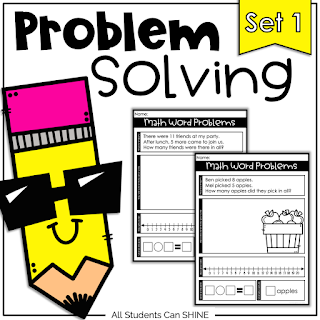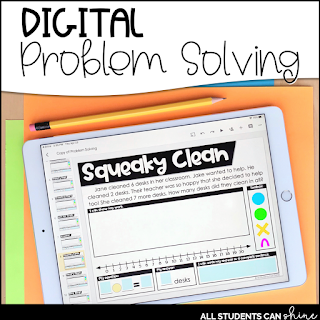Math can be a challenge for students once it gets past the fluency stage and into the conceptual stage. Why is it that even our kids who are quick to learn math facts still struggle with solving math problems? Even with lots of practice, some of our primary students shut down when it comes to higher level mathematical thinking.
I’ve got great news, teachers! There are plenty of great ways to help kids understand the problem solving process, and once you keep a few things in mind, you’ll have the tools to help your students find problem solving success!
I feel so much satisfaction watching kids make sense of concepts and feel successful! That feeling is definitely worth taking some extra time to make their learning “stick.” A few shifts in your practice in the classroom will help your students feel their accomplishment. It’s the best when they can take part in creating their understanding, instead of just being told what to do.
The key to helping kids find that spark is in the application. Math facts and fluency are important, but in the end, true learning comes from the way our students independently organize, think about, and work through problems.
Why Students Struggle With Math Problems
First, let’s identify some of the main struggles kids face when attempting to solve math problems, and the solutions to overcome them.
1. Math problems are often far from being meaningful. NO ONE buys 57 watermelons ever, do they??
- For kids to conceptualize problems, we have to make them more realistic. We have to get away from focusing just on the numbers and focus on the processes by giving them relevant problems they care about. You know your kids. Use what is interesting and even culturally relevant to them. Use their language and ideas, and integrate them with math vocabulary to create relevant and engaging problems they actually want to solve.
2. Kids often struggle with multi-step problems. Usually this is because they’ve never mastered one-step problems.
- Teach one step at a time. Why rush it? Practice understanding the problem and then move on to making a plan to solve it. All the parts of problem solving depend on mastering the step before it. Take it slow and really cement that understanding what the problem is telling you first before applying the next step.
3. Kids with language or reading difficulties feel overwhelmed. How can we expect struggling readers to be good at problem solving if they can’t read or understand the problem?
- Teaching kids to recognize and understand keywords and mathematical vocabulary has to come before they understand what to do with it. There are lots of center and whole group activities to help with this. You can also access this free math poster to display and give your students access to important key words.
4 Steps to Successfully Teach Problem Solving
Once you’ve addressed those roadblocks, you can focus on these 4 steps for teaching problem solving:
- Understand the problem
- Make a plan
- Solve the problem
- Check your solution
Remember: Try teaching one step at a time. No need to solve a problem right away. Practice understanding problems and then move on to making plans. No need to teach all the steps at once if that’s overwhelming your students.

Understand the problem
- Practice reading the problem more than once.
- Ask questions to check for understanding.
- Highlight important information & cross out what isn’t needed.
- Have them turn to their elbow buddy and explain the problem in their own words.
- Make sure it is clear what we are looking for (the question that needs to be answered)
Make a plan
- Look for keywords in the problem. Display my free math poster {freebie} in your classroom for quick reference.
- Use different strategies with your students such as acting out the problem, making a model, drawing a chart, etc…
- Use different strategies on paper such as number lines, ten frames, number bonds, etc…
Solving the problem
Don’t let your students write the answer and forget about the rest. They often skip the “show your work” part because “if I know the answer, who cares about the rest??”.
Practice this by having kids only solve the problem using the chosen strategy but not writing the answer. For example, in primary grades, we often draw a picture to solve problems. Practice a few problems by demonstrating the picture and not writing the answer. After a few lessons, incorporate the answer by adding an equation to your solution.
Check your solution
My favorite way to get kids to check their answer is by using a second strategy to solve the problem. For example, if they drew a picture to add 5 owls and 4 falcons, have them then use a number line to see if they get the same answer.
Comparing their answer with a friend is another strategy. Talk is an important part of math!

No-Prep Resources to Teach Problem Solving
Looking for some no-prep resources to guide your math instruction? Check out these two links here, and here for problem-solving resources. If your students are distance learning, they can use this Google Slides resource from my TPT store.









